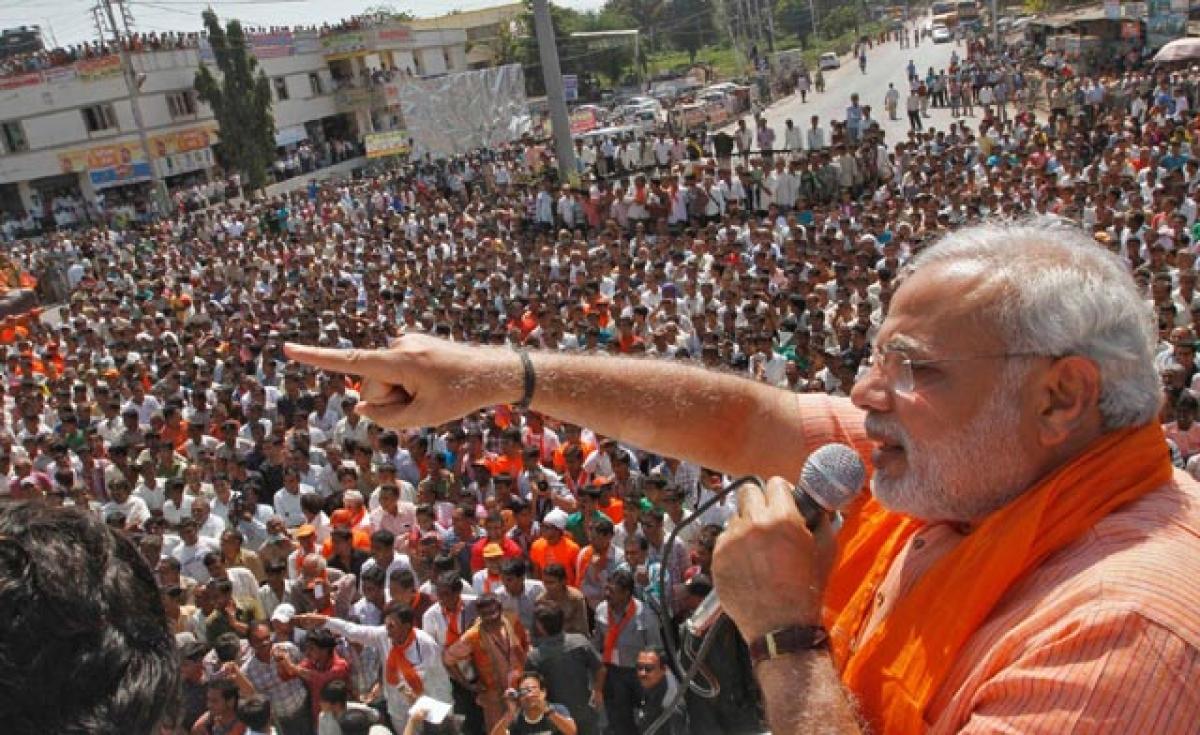Live
- Chanchalguda Jail Officials Say They Haven't Received Bail Papers Yet, Allu Arjun May Stay in Jail Tonight
- BJP leaders present evidence of illegal voters in Delhi, urge EC for swift action
- Exams will not be cancelled: BPSC chairman
- Nagesh Trophy: Karnataka, T.N win in Group A; Bihar, Rajasthan triumph in Group B
- YS Jagan condemns the arrest of Allu Arjun
- Economic and digital corridors to maritime connectivity, India and Italy building vision for future, says Italian Ambassador
- SMAT 2024: Patidar's heroics guide Madhya Pradesh to final after 13 years
- CCPA issues notices to 17 entities for violating direct selling rules
- Mamata expresses satisfaction over speedy conviction in minor girl rape-murder case
- Transparent Survey Process for Indiramma Housing Scheme Directed by District Collector
Just In

It has taken two years but, finally, Narendra Modi appears to have found his feet. In a recent interview, he demonstrated his grip on the situation by covering wide areas of national and international affairs.
It has taken two years but, finally, Narendra Modi appears to have found his feet. In a recent interview, he demonstrated his grip on the situation by covering wide areas of national and international affairs. The earlier silences on crucial issues such as the rampages of saffron mobs and the snide attacks on selected targets by self-appointed saviours of the nation are no longer in evidence.
Given his command performance of over 90 minutes (on TV), it is odd that he does not engage in more such interactions with media personnel either individually or collectively. Such an initiative will dispel the impression that he is wary of the media, probably because of his experience during and after the Gujarat riots.
Along with wide-ranging press conferences, Modi can indulge in more humorous exchanges, shedding his present inhibitions born of the ‘fear’ as he has admitted, of the media taking a word of his comments out of the context and blowing it out of proportion. His apprehension that humour can be ‘risky’ is unwarranted. So is the belief in the media’s mischievousness. Of all the leaders, he is better placed than anyone else to inject an element of wit and drollery in public life because of his own and his party’s secure political position and his high personal ratings.
Neither Sonia Gandhi nor Rahul Gandhi can afford to look at the funny side of things if only because there may not be any in their view. It is the same with the regional orders. Even the stability of their political positions does not make Mamata Banerjee or Jayalalithaa or Nitish Kumar any less tense. In Modi’s case, however, his body language during the interview underlined his confidence.
The reason apparently is his success in pinpointing both his successes and difficulties. At home, Modi has had no hesitation in stating that only one party has been stalling parliamentary debate. In foreign affairs, he is happy about the warmth of the relations with the US and concerned about the hurdles posed by the multiple centres of authority in Pakistan.
China is a problem, but it has been told that the government will not hesitate to take care of India’s interests. That should make it less adventurous in the border areas. That the Prime Minister referred to the positive editorials in American newspapers after his visit to the US emphasised the disadvantages of keeping Indian journalists, except one, at arm’s length which, according to a saffronite, has set off a ‘fratricidal war’ in the media.
Such an interpretation, which maliciously distorts the competitive nature of journalism, is the adverse fallout of being selective, which does not suit a Prime Minister. Interestingly, Modi’s criticisms were all veiled. He did not name the Congress for its obstructionism, nor Subramanian Swamy for his publicity-seeking stunts.
But the snubs have hit their mark, especially where Swamy is concerned. The prime minister’s advice to the media not to make ‘heroes’ of the hotheads was also well directed since there has been a tendency in the Third Estate to single out relatively minor incidents of saffron excesses to slam the Bharatiya Janata Party (BJP) and the Sangh Parivar.
Notwithstanding, the confidence which the prime minister displayed, his assurances on development in the context of the Uttar Pradesh elections are more likely to be believed if the BJP visibly dissociates itself from the Hindutva extremists by showing that it doesn’t consider them to be ‘heroes’. Since Uttar Pradesh is the biggest prize to be won before the next general elections, it will prove the veracity of Modi’s assertion vis-à-vis the unstable ground reality in the state.
If, as Modi believes, the new generation only believes in development, the BJP should have no hesitation in shunning the militants in its ranks. In that case, the party should be able to repeat its outstanding feat of 2014 when it won 73 of the State’s 80 parliamentary seats. But, as of now, the signs are not wholly reassuring.
Even then, it is to Modi’s credit that he has been able to turn the focus on his party’s policies to development from the militant Hindutva of the 1990s.The next step is to further illumine the present-day ‘bright spot’ of the Indian economy amid the encircling gloom of the international economic scene, as the World Bank group president, Jim Yong Kim, has said.
In this field, the test lies in ensuring the parliamentary passage of the goods and services legislation, which now has a greater chance because of the increasing support to the government by the regional parties. Its passage cannot but create an atmosphere of buoyancy. Once this hurdle is crossed, it is only the fraught relations with China and Pakistan which will be a matter of worry. In other respects, the country’s forward march is obvious as in satellite technology and military preparedness.
By Amulya Ganguli

© 2024 Hyderabad Media House Limited/The Hans India. All rights reserved. Powered by hocalwire.com







